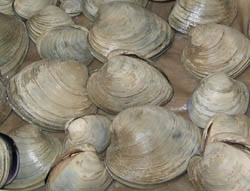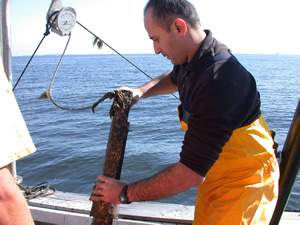Raritan Bay lies between Staten Island and the north coast of New Jersey in New York Harbor. The New York waters of the Bay have been closed to shellfish harvest for direct human consumption for decades because of bacterial contamination. However, throughout this period, there has still been a lot of shellfish digging in the Bay. Beginning in 1987, the New York State Department of Environmental Conservation (DEC) has overseen a clam relay project in which hard clams (Mercenaria mercenaria) growing in uncertified waters of the Bay are removed by private diggers and transported under DEC’s watchful eye to certified waters on eastern Long Island. There, the shellfish are left for a minimum of 21 days to purge themselves of any pathogens, at which time they become available for public harvest. By the year 2000, nearly 45% of New York yearly hard clam harvest was coming from the transplant project.
However, disaster struck in late 2002 when reports of many dead and moribund clams in the clam transplant areas in the Bay reached DEC. Over the ensuing months, DEC turned to Dr. Bassem Allam, newly-arrived at SoMAS’s Marine Animal Disease Laboratory (MADL), to diagnose the reason(s) for the mortalities and what might be done to mitigate or avoid them. Because of the concern that moving potentially diseased clams out to clean waters on eastern Long Island might only spread whatever disease agent(s) might be at work, DEC closed the shellfish transplant project for 2004 and 2005, a significant economic impact to hard-pressed waterfront communities.
Initial analyses by Dr. Allam and his students in early 2003 identified the causative agent as a parasite, denominated Quahog Parasite unknown or QPX. Clam beds in Massachusetts and Virginia had been hit hard by QPX beginning in the 1990’s. Collaborative monitoring by DEC and Allam found heavy QPX infestations in many of Raritan Bays 10,000+ acres of the Bay designated as transplant harvest areas. Professor Allam is a specialist in the pathobiology and immunobiology of marine shellfish. Along with the monitoring of QPX distribution and abundance, he initiated an extensive research program on this environmentally opportunistic parasite to determine the species’ life history traits, the environmental conditions under which it thrived and the dynamics involved in the host/parasite (clam/QPX) relationship.
Hard clams are a major part of the seafood industry in New York, valued at approximately $15 million per year, said Allam. Though QPX is not known to infect people, the parasite kills the clams.
“The resource where the parasite was discovered accounted for almost half of the (New York) production, half of the production came from Raritan Bay and this is where the disease was discovered and production was stopped entirely,” said Allam. Monitoring of the parasite in Raritan Bay continued. Through 2003 and 2004, levels declined significantly in several harvest areas. Based on these results, DEC re-opened about 25% of the harvest areas in the Bay for the 2005 season (April – October). Today, these areas remain open and the Raritan Bay Transplant Project is again providing income to New York commercial shellfish diggers. Allam’s team continues to monitor the harvest areas in the Bay with help from DEC.
QPX was first discovered in Canada in the 1950s, but little research was done on the organism, said Allam, despite the infestations in Massachusetts and Virginia. Thus, several questions must still be answered and these form the core of his research program, which receives financial support from DEC, the New York Sea Grant Program and the National Science Foundation.
“There’s a lot of mystery about how QPX infects clams,” said Allam. “Can the clams fight the infection? Can they survive or do infected clams always die? What factors predisposed an area to an outbreak of the disease? These things were totally unknown when we started. We started from scratch.”
Allam and his team do original research to understand the factors that impact disease development and how clams respond to the infection. Part of this work involves a state-of-the-art molecular investigation of host/pathogen interactions involving clams and the QPX organism. The initial technique employed by Allam and co-worker Jackie Collier, another member of the SoMAS faculty, was Quantitative Real-Time Polymerase Chain Reaction, also known as Quantitative PCR. This technology allows very low levels of the parasite to be detected. Significant progress has been made in the genetic sequencing of both the parasite and the clam transcriptome.
But this isn’t Allam’s only work focused on QPX.
“Last year, we developed a micro-array technology, which is a great way to assess gene regulation at large scale,” said Allam. On a slide, there can be up to eight rectangle specimen supports and each of these supports has over 15,000 clam or parasite genes that can be studied at one time. The technique was developed by Allam and his colleagues in France during a recent research sabbatical. A unique aspect of this technology is that either the clam or parasite can be studied in one single experiment.

Bassem Allam and team before before they get busy (note tray of hard clams on the right). L to R: front row: Emmanuelle Pales-Espinosa, Kailai Wang, Sue Pawagi; middle row: Ewelina Rubin, Joyce Lau, Lauren Sussman; back row: Bassem Allam, Soren Dahl, Jesse Hornstein
If a gene is expressed, Allam and his team may collect the specimen’s Messenger Ribonucleic Acid, or mRNA, a nucleic acid that synthesizes proteins. In turn, the team may synthesize matches for these sequences.
Testing is being done on two conditions in the clams—infected and healthy. On the slides themselves, the samples are labeled in two colors, red and green. “They will competitively hybridize on the corresponding gene,” said Allam. “If one gene is highly expressed in one sample and you label that sample with green, you will have a green spot, if the disease is highly expressed and you label the disease red, you will have red spot.”
The micro-array method is faster than Quantitative PCR, which can measure and analyze only one gene at a time.
“Because we are in gene discovery, we don’t know how the clam responds…gene discovery in terms of understanding how molecular immunity operates, how the clam responds to the infection, for example, at the molecular level,” said Allam. “So instead of targeting one gene that may be responsible or may not, you cover all genes and you see what changed and then you go forward in the investigation.”
Experiments have not only been run on the immunity and infected versus uninfected clams but the impact of environmental factors on the development of disease has been thoroughly assessed.
“We know that temperature impacts disease development….we confirmed that temperature impacts disease development,” explained Allam, who said seasonality also plays a role in QPX’s virulence. “We are trying to understand how the molecular pathways are regulated by temperature, leading to more resistance or more susceptibility.”
Salinity, too, has an impact upon disease development. Further, there appears to be a genetic predisposition to QPX among clams.
“Different clam strains clearly have different resistance levels to the infection; the resistance itself has a genetic determinant,” said Allam. “And this is where molecular techniques really come into play and allow you to identify those genes that really are involved and responsible.”
Further information on the research of Dr. Allam and colleagues on the diseases of bivalve shellfish is available here.







You must be logged in to post a comment.